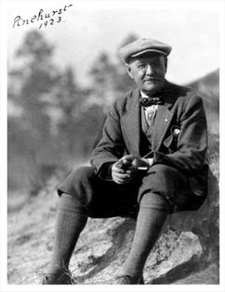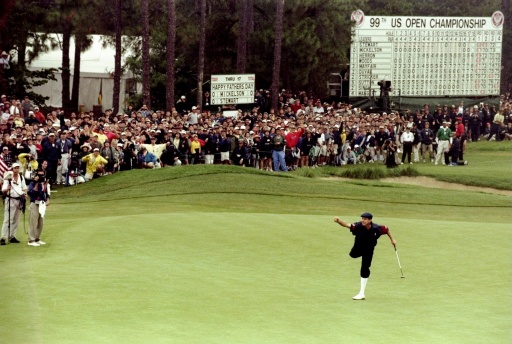 Donald Ross (1872-1948) was born at Dornoch in Scotland. He grew up playing the famous Royal Dornoch golf links and apprenticed under “Old” Tom Morris for a year at St. Andrews. Ross’ name has become synonymous with golf and as a testament to his genius, there are nine of his courses on Golf Digest’s list of America’s 100 Greatest Golf Courses.
Donald Ross (1872-1948) was born at Dornoch in Scotland. He grew up playing the famous Royal Dornoch golf links and apprenticed under “Old” Tom Morris for a year at St. Andrews. Ross’ name has become synonymous with golf and as a testament to his genius, there are nine of his courses on Golf Digest’s list of America’s 100 Greatest Golf Courses.
Ross had settled into a relatively comfortable life in Scotland before a Harvard professor, studying and enjoying golf in its homeland, persuaded him to come spread the game in the United States. Professor Robert Wilson invited Ross to the States and he arrived in 1899. Ross invested his life savings in the trip and we’re glad he took the risk.
 In those days someone associated so closely with the game could not just be a designer. Ross learned to play the game, design courses, maintain the grounds, and make clubs. He was another of golf’s renaissance men, learning course design literally from the ground up. His regular play and mind for the game gave him an unusual understanding of what was necessary in creating interesting and challenging tests of golf at all his designs.
In those days someone associated so closely with the game could not just be a designer. Ross learned to play the game, design courses, maintain the grounds, and make clubs. He was another of golf’s renaissance men, learning course design literally from the ground up. His regular play and mind for the game gave him an unusual understanding of what was necessary in creating interesting and challenging tests of golf at all his designs.
Interestingly enough, he never set foot on some of his courses because of the difficulty of travel. He would examine topographical maps and send instructions to his crew from his office, working on the courses from far-away locations. One notable exception is Pinehurst No. 2, a course with which he tinkered for decades. Thankfully his tinkering didn’t remove the raw simplicity from what’s been called “America’s Old Course.”
One of Ross’ most important contributions to Pinehurst golf was his use of Bermuda grass on Pinehurst No. 2’s greens. No longer were players forced to putt on oiled sand, a practice which is totally foreign to modern golf (thankfully). The experience he gained growing and managing turf in Scotland helped him to produce healthy and playable putting surfaces in the States.
Ross’ vision was to “arrange the course so that every stroke must be made with a full concentration and attention necessary to good golf.” I found this out when The Sand Trap staff played together at the Newport Cup last October. In my estimation, the most beautiful and challenging course we played was Ross’ Pine Needles Golf Club. At first glance this course looked benign and harmless. There were no waterfalls or fountains gracing the landscape and golf balls were not easily lost but it had a way of piling strokes on when you least expected it. There were many times that I cursed Ross under my breath for the way he designed the greens. I’d have spent three weeks there if I could.
Pine Needles was apparently one of Ross’ favorite designs. “Ross played a good deal of golf at Pine Needles in his later years and I think he tinkered there a bit,” said Michael Fay, writer of Golf, as it was Meant to be Played and co-founder of The Donald Ross Society. Pine Needles’ owners employed golf architect John Fought to restore the course to what Ross had originally had envisioned. Greens were expanded and some of the green’s crowns were diminished. Ron Whitten suggested in a June 2005 Golf Digest article that Donald Ross wouldn’t recognize his own greens.
Probably the first thing that comes to the mind of a golf fanatic when someone mentions Donald Ross design are his crowned or turtleback greens. Modern players often attack greens from the air but in Ross’ day, the bump-and-run was the shot of choice when approaching a green. Ross designed his greens to repel shots that were off-line, and he did so by creating a slight crown around his greens to protect them. Whitten suggested that the methods employed to care for greens in years past exaggerated Ross’ slopes and created “turtleback greens,” most notably at Pinehurst No. 2.

A sand top-dressing was applied to greens sometimes as much as a quarter of an inch at a time which, over time, created the greens we see today. It is apparent from old photographs that Ross didn’t intend his greens to be so pronounced. Nevertheless, they make for some of the most challenging greens to approach because they require precision to hit and hold. Those greens confounded Tiger Woods last year at the U.S. Open. Notable designer Pete Dye suggested that Ross would probably remove the crowns given the chance.
One of the greatest moments in U.S. Open history was written on the 18th green the No. 2 course when Payne Stewart sunk a masterful putt to win the 1999 U.S. Open. I believe the USGA loves No. 2 for Open venues because it can easily be made a monster by growing the rough and speeding up the greens. You try and hold a Ross green from 150 yards when it’s a 12 on the stimpmeter! Bobby Jones called Pinehurst No. 2 the “St. Andrews of United States Golf.” Beautiful in their simplicity and perhaps maddening in their ball-repelling efficiency, Donald Ross’ golf courses are very special.
Ross was not only a great designer, he was a masterful player and teacher. He won three North and South Opens and two Massachusetts Opens. In 1903 he finished fifth in the U.S. Open and eighth in the 1910 British Open. His design business obviously overshadowed his playing career as his courses are a visible and present contribution to golf today. His more famous courses include Pinehurst No. 2, Seminole, Oak Hill, and Oakland Hills.
It is very interesting to see how golf developed in the United States and Donald Ross is certainly a key contributor. Ross’ designs are high on my list of courses to play because of that afternoon I spent at Pine Needles. I can forgive him the grief he caused me around the greens and look forward to a chance to redeem myself in the future.
Photo Credit: The Maplewood Country Club & Resort, Golferen.
I’ve played Ross’ Aronomink in PA. Spectacular course. I’m definitely a fan of his design.
Donald Ross was obviously a one of the best designers in our country’s history. This is evident in his course in Florida, Seminole. The genius of the routing of this golf course is unparalleled in America. Truly a masterpiece.
Kudos to your article mentioning how Donald Ross would not have liked the way his greens developed a “crown” over the years of seeding and topdressing. All of his designs began with a “table top” approach more in keeping with his Dornoch upbringing. When you play Donald Ross courses they all feel the same – challenging, unique, and familiar. There are gems all of this country!
great